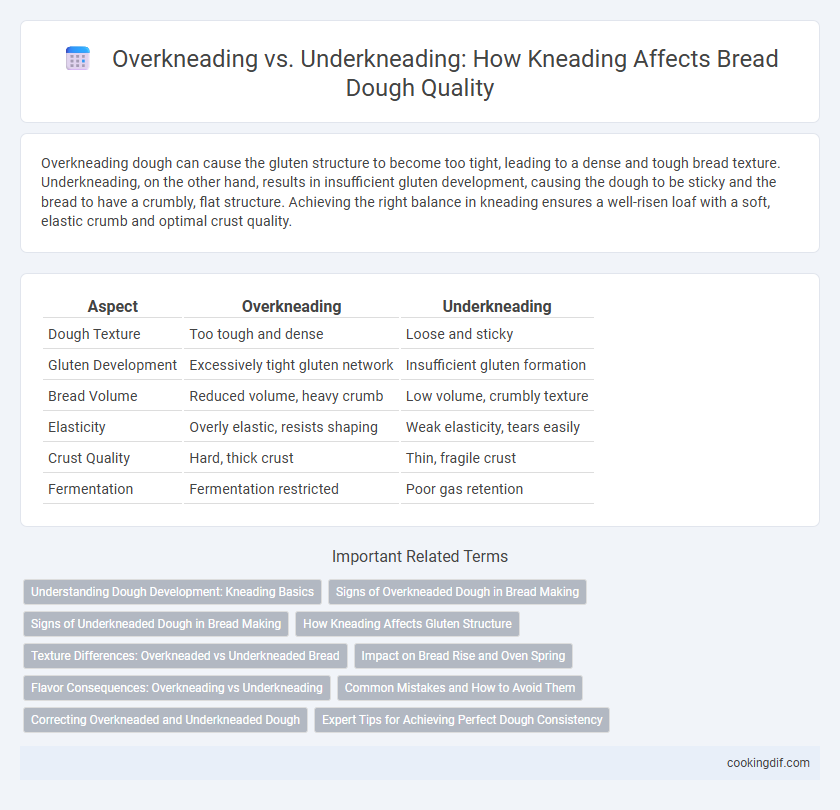Overkneading dough can cause the gluten structure to become too tight, leading to a dense and tough bread texture. Underkneading, on the other hand, results in insufficient gluten development, causing the dough to be sticky and the bread to have a crumbly, flat structure. Achieving the right balance in kneading ensures a well-risen loaf with a soft, elastic crumb and optimal crust quality.
Table of Comparison
| Aspect | Overkneading | Underkneading |
|---|---|---|
| Dough Texture | Too tough and dense | Loose and sticky |
| Gluten Development | Excessively tight gluten network | Insufficient gluten formation |
| Bread Volume | Reduced volume, heavy crumb | Low volume, crumbly texture |
| Elasticity | Overly elastic, resists shaping | Weak elasticity, tears easily |
| Crust Quality | Hard, thick crust | Thin, fragile crust |
| Fermentation | Fermentation restricted | Poor gas retention |
Understanding Dough Development: Kneading Basics
Overkneading dough causes gluten strands to become too tight, resulting in a tough, dense bread with poor rise and crumb structure. Underkneading leaves gluten underdeveloped, producing a dough that is sticky, weak, and prone to collapsing during baking. Proper dough development requires kneading just until the gluten network is elastic and smooth, allowing optimal gas retention and a light, airy loaf.
Signs of Overkneaded Dough in Bread Making
Overkneaded dough often appears excessively tough and tight, resulting in bread with a dense, hard crumb and reduced rise. Visible signs include dough that resists stretching, tears easily, and lacks elasticity, making shaping difficult. This compromises gluten structure and results in a coarse, dry texture in the final loaf.
Signs of Underkneaded Dough in Bread Making
Underkneaded dough exhibits a dense texture with poor gluten development, leading to bread that is heavy and lacks proper rise. Signs include a sticky, shaggy consistency and dough that tears easily instead of stretching smoothly. These characteristics result in bread with uneven crumb and reduced volume, compromising overall quality.
How Kneading Affects Gluten Structure
Kneading directly influences gluten development, with overkneading causing the gluten strands to break down and result in a dense, tough bread texture. Underkneading leads to insufficient gluten formation, producing a dough that is sticky, weak, and lacks elasticity, which affects the bread's rise and crumb structure. Optimal kneading achieves a strong, elastic gluten network that traps gas bubbles, creating a light and airy crumb.
Texture Differences: Overkneaded vs Underkneaded Bread
Overkneaded bread dough develops a dense, tough texture due to excessive gluten formation, leading to tight, chewy crumb structures and reduced oven spring. Underkneaded dough results in a coarse, crumbly texture with irregular holes and poor dough elasticity, causing flat loaves with uneven crumb. Proper kneading balances gluten development, ensuring a soft, airy crumb and ideal bread texture.
Impact on Bread Rise and Oven Spring
Overkneading dough leads to an overly tight gluten network, restricting gas expansion and resulting in poor bread rise and reduced oven spring. Underkneading produces a weak gluten structure, causing insufficient gas retention and a dense, flat loaf with minimal volume increase during baking. Optimal kneading balances gluten development to maximize dough elasticity, ensuring a strong rise and impressive oven spring for airy, well-structured bread.
Flavor Consequences: Overkneading vs Underkneading
Overkneading dough results in a dense texture and a muted flavor profile due to gluten structure being overly developed, which traps fewer fermentation gases and limits yeast activity. Underkneading produces uneven gluten networks, causing crumbly bread with coarse holes and a less complex, often yeasty or sour taste from insufficient fermentation. Achieving optimal kneading balances gluten formation, enhancing both the bread's flavor complexity and texture.
Common Mistakes and How to Avoid Them
Overkneading dough causes gluten strands to become too tight, resulting in dense, tough bread with poor rise, while underkneading leads to weak gluten development, yielding crumbly, flat loaves. Common mistakes include using excessive mixing time or insufficient kneading duration, both harming dough elasticity and texture. Avoid these errors by kneading until the dough passes the windowpane test--stretching thin without tearing--ensuring optimal gluten formation for a balanced bread structure.
Correcting Overkneaded and Underkneaded Dough
Overkneaded dough results in a tough, dense texture due to gluten strands being excessively developed, while underkneaded dough remains sticky and lacks elasticity because gluten is insufficiently formed. To correct overkneaded dough, allow it to rest at room temperature for 20-30 minutes to relax the gluten, improving extensibility before shaping. For underkneaded dough, continue kneading until the dough becomes smooth and elastic, with a windowpane test confirming proper gluten development.
Expert Tips for Achieving Perfect Dough Consistency
Overkneading dough can lead to a tough, dense crumb by overdeveloping gluten, while underkneading results in a sticky, loose dough lacking structure and rise. Experts recommend kneading until the dough is smooth, elastic, and slightly tacky to the touch, which allows optimal gluten formation and gas retention. Using the windowpane test--stretching a small dough piece until translucent without tearing--ensures perfect dough consistency for superior bread quality.
Overkneading vs underkneading for dough quality Infographic

 cookingdif.com
cookingdif.com